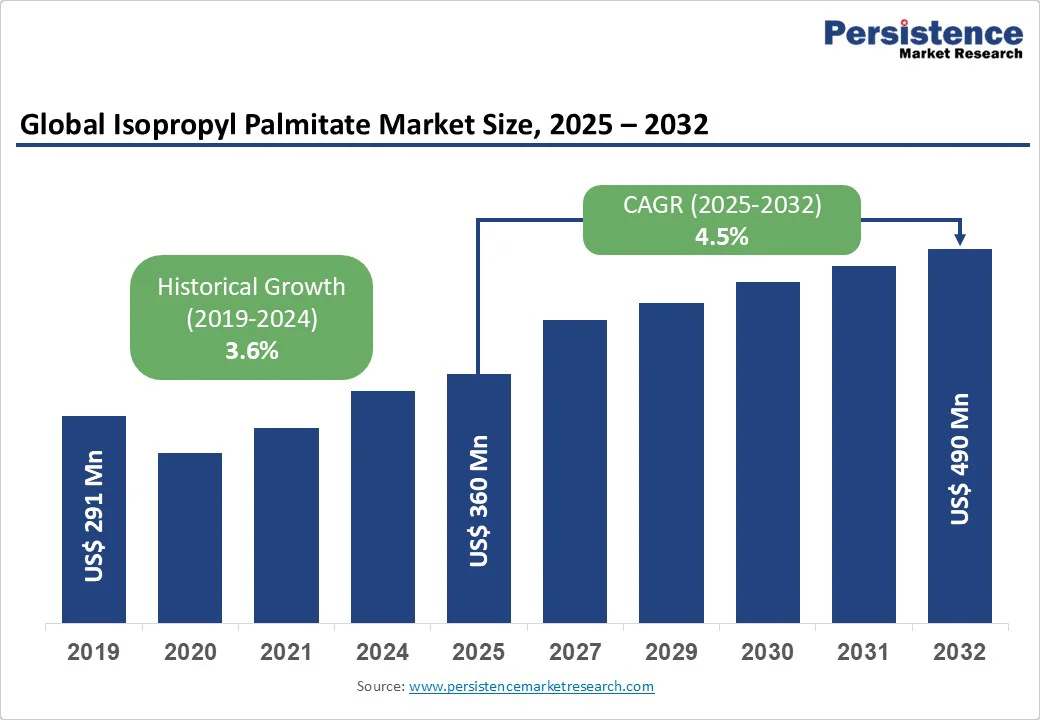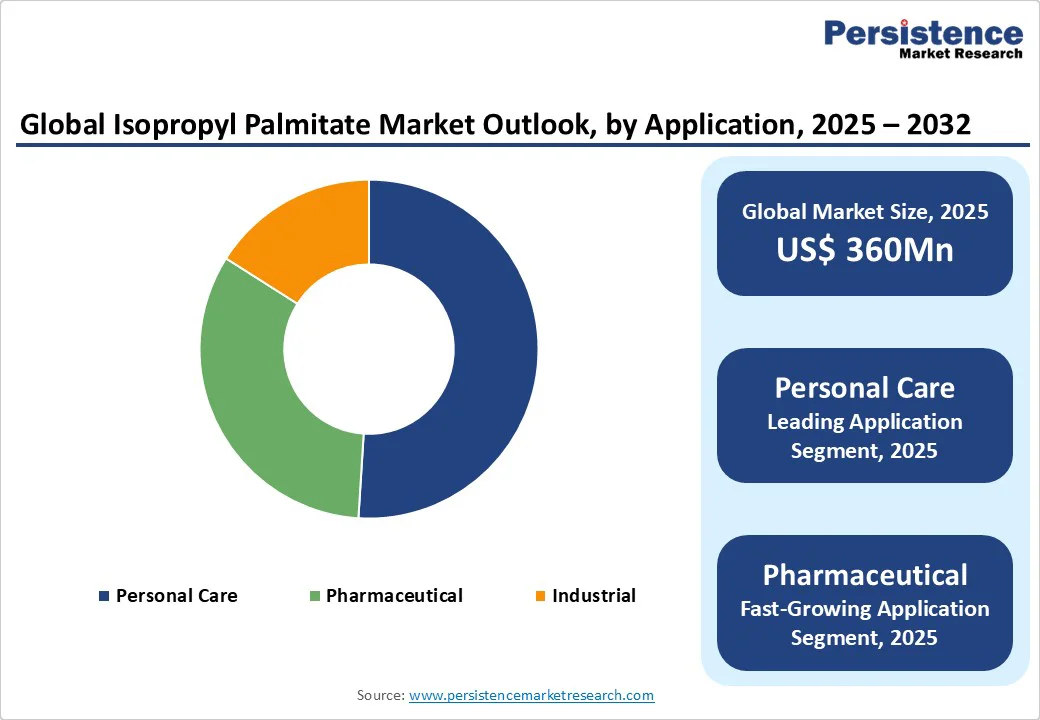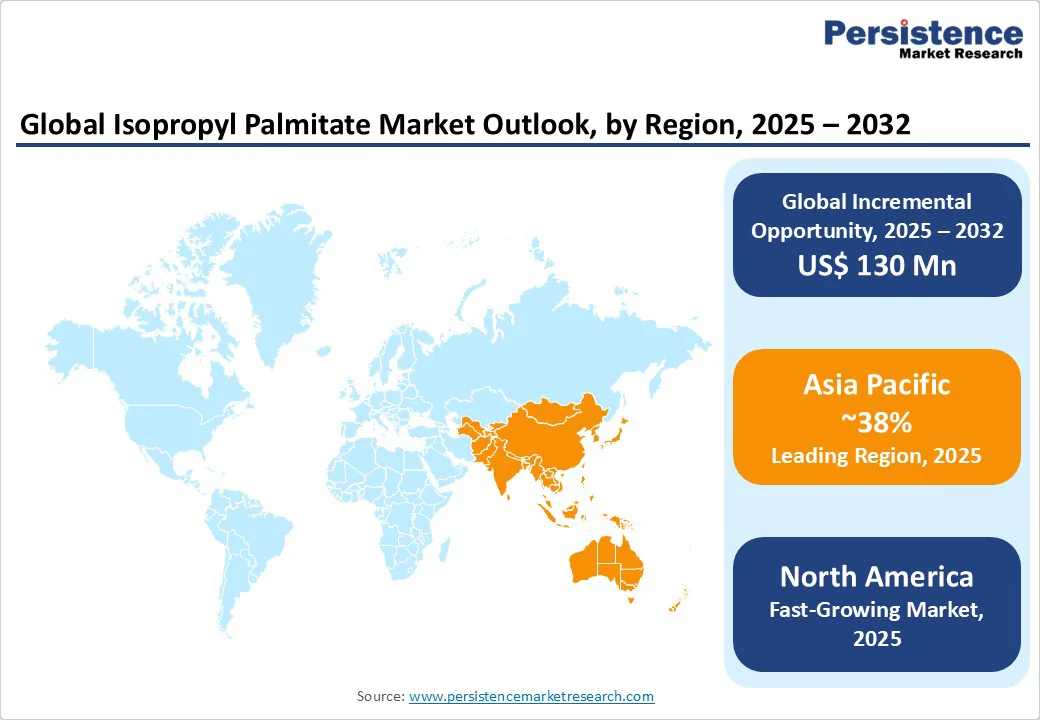ID: PMRREP31094| 187 Pages | 26 Sep 2025 | Format: PDF, Excel, PPT* | Chemicals and Materials

The global isopropyl palmitate market size is likely to be valued at US$ 360 Mn in 2025 and is expected to reach US$ 490 Mn by 2032, growing at a CAGR of 4.5% during the forecast period from 2025 to 2032.
The isopropyl palmitate market has experienced steady growth, driven by the increasing demand for emollients in personal care products, rising adoption of high-purity ingredients in pharmaceuticals, and advancements in sustainable chemical manufacturing.
| Key Insights | Details |
|---|---|
| Isopropyl Palmitate Market Size (2025E) | US$ 360 Mn |
| Market Value Forecast (2032F) | US$ 490 Mn |
| Projected Growth (CAGR 2025 to 2032) | 4.5% |
| Historical Market Growth (CAGR 2019 to 2024) | 3.6% |

The increasing deployment of personal care products is a major driver shaping the landscape, fueled by rising consumer awareness about health, wellness, and hygiene. Growing urbanization and changing lifestyles have amplified the demand for products such as moisturizers, shampoos, lotions, deodorants, and cosmetics that not only enhance appearance but also support daily self-care routines.
For instance, the skincare industry has witnessed exponential growth due to heightened concerns about pollution, UV exposure, and premature aging, encouraging consumers to invest in sunscreens, anti-aging creams, and organic formulations.
The expansion of men’s grooming products, including beard care, hair styling gels, and specialized skincare lines, reflects the broadening demographic base of the sector. E-commerce platforms have also played a critical role by making a wide variety of personal care products easily accessible, offering competitive pricing and personalized recommendations.
Additionally, increasing disposable incomes, particularly in emerging economies, are encouraging consumers to shift from basic hygiene items to premium personal care solutions. This rising penetration and diversification of products across categories continues to accelerate global market growth, creating opportunities for innovation, sustainable packaging, and ingredient transparency.
High development and regulatory costs act as a significant restraint on the personal care market, particularly within skincare, cosmetics, and hygiene product segments. Bringing new products to market requires extensive investment in research and development (R&D), clinical testing, and safety assessments to ensure efficacy and consumer safety.
For instance, developing an advanced anti-aging cream or sunscreen involves not only sourcing high-quality active ingredients but also conducting dermatological trials, stability testing, and consumer evaluations, which add to overall expenses.
Companies must navigate complex regulatory frameworks that vary by region. Authorities such as the U.S. Food and Drug Administration (FDA), the European Medicines Agency (EMA), and the European Chemicals Agency (ECHA) impose strict compliance requirements covering product formulation, labeling, packaging, and advertising claims.
Meeting these standards demands considerable time and financial resources, particularly for smaller and emerging brands. Moreover, compliance with international regulations, including REACH in Europe or COSMOS standards for organic products, further increases costs. These high barriers can slow innovation, reduce profit margins, and limit the entry of startups into the competitive personal care market, thereby restraining growth potential.
Advancements in modular and bio-based ester technologies present a significant opportunity for the personal care industry, offering sustainable, high-performance alternatives to traditional synthetic ingredients. Bio-based esters, derived from renewable resources such as plant oils, sugarcane, or algae, are gaining traction due to rising consumer demand for eco-friendly and skin-friendly formulations.
Their multifunctional properties, ranging from emollience and moisturization to improved texture and spreadability, make them particularly attractive for skincare, haircare, and cosmetic products. Modular technologies, on the other hand, enable manufacturers to tailor esters with specific molecular structures that deliver targeted benefits, such as enhanced stability in sunscreens, improved sensory feel in lotions, or long-lasting effects in color cosmetics.
For instance, companies such as Croda International and Evonik Industries are actively developing bio-based esters that combine superior performance with lower carbon footprints, helping brands align with sustainability goals and regulatory requirements.
Modular ester platforms allow formulators to innovate rapidly, addressing niche consumer needs such as hypoallergenic, vegan, or biodegradable products. This convergence of sustainability, customization, and performance creates a fertile ground for product differentiation, premiumization, and market expansion. As both consumer expectations and regulatory pressures evolve, the adoption of bio-based and modular ester technologies will accelerate, positioning them as key growth drivers in the personal care market.
Greater than or equal to 95% dominates, expected to account for approximately 55% of the share in 2025. Its dominance stems from its cost-effectiveness, rapid production cycles, and ease of integration into mass-market formulations for applications such as lotions and industrial cleaners.
Standard-grade isopropyl palmitate, such as that offered by BASF and Croda, enables efficient emulsification, broad compatibility, and seamless scalability across missions, making it a preferred choice for industries such as commercial cosmetics and manufacturing.
The greater than or equal to 99% segment is the fastest-growing, driven by industries with high-purity requirements, such as pharmaceuticals and premium skincare. High-purity isopropyl palmitate offers superior clarity and low residue, appealing to large enterprises with sensitive formulations.
The growing focus on clean-label products and advanced drug delivery, such as transdermal systems, is accelerating the adoption of premium grades in regions such as North America and Europe, with significant growth potential in high-stakes applications.
Personal care leads the isopropyl palmitate market, holding a 51% share in 2025. The segment’s dominance is driven by the need for efficient skin conditioning and texture enhancement in expanding beauty networks, particularly in daily-use products such as creams and shampoos. Isopropyl palmitate streamlines the integration of active ingredients, reduces greasiness, and improves spreadability, making it critical for providers such as Procter & Gamble and Johnson & Johnson.
The pharmaceutical segment is the fastest-growing, fueled by the rapid growth of topical therapies and the need for reliable excipients in ointments and gels. The rise in dermatological treatments and over-the-counter medications has spurred the adoption of high-purity isopropyl palmitate. The Asia Pacific region, with its booming pharma needs, is driving rapid adoption in this segment amid increasing chronic skin condition prevalence.

North America is emerging as the fastest-growing market in the automotive sector, driven by a combination of changing consumer preferences, technological innovation, and regulatory support for cleaner mobility.
The rising popularity of SUVs and crossover vehicles has significantly contributed to overall vehicle sales, as consumers increasingly favor larger, more versatile vehicles for both urban commuting and recreational use. Simultaneously, the adoption of electric vehicles (EVs) is accelerating, supported by government incentives, tax rebates, and the expansion of charging infrastructure across the region.
Advanced automotive technologies, including autonomous driving features, connected vehicle systems, and enhanced safety mechanisms, are further stimulating demand, prompting manufacturers to integrate sophisticated components and high-performance materials into their vehicles.
For instance, luxury and mid-range SUVs increasingly feature driver-assist systems, smart infotainment, and lightweight materials for fuel efficiency, driving growth in related automotive components. Consumer awareness of sustainability and energy efficiency is encouraging automakers to innovate in battery technologies, lightweight composites, and electrified powertrains.
The combination of strong consumer demand, regulatory support, and continuous technological advancements positions North America as a critical growth hub, offering significant opportunities for manufacturers and suppliers in both conventional and electric vehicle segments.
Europe isopropyl palmitate market is experiencing steady growth, driven by rising demand for multifunctional ingredients in the cosmetics and personal care industry. The growth is fueled by increasing consumer preference for lightweight, non-greasy emollients that improve skin texture, enhance spreadability, and provide long-lasting moisturization.
For instance, isopropyl palmitate is widely used in skincare formulations such as sunscreens, anti-aging creams, and lotions, as well as in haircare and color cosmetics, where a smooth finish and superior sensorial feel are essential. Strict European Union cosmetic regulations, however, place strong emphasis on ingredient safety, environmental compliance, and sustainable sourcing, encouraging manufacturers to focus on bio-based and RSPO-certified alternatives.
Clean beauty trends across the region are further shaping demand, as consumers increasingly seek natural, non-comedogenic, and environmentally responsible products. While raw material sourcing and sustainability certifications raise production costs, innovation in bio-based ester technologies is creating opportunities for differentiation. Overall, Europe remains a key market where regulatory rigor and consumer awareness combine to foster sustainable yet performance-oriented growth.
Asia Pacific, holding a 38% share, stands as the dominant region in the global isopropyl palmitate market, fueled by a combination of economic, industrial, and consumer-driven factors. The region is home to some of the world’s largest automotive manufacturing hubs, including China, India, Japan, and South Korea, which collectively contribute to high vehicle production volumes.
Rapid urbanization across emerging economies is driving significant growth in vehicle ownership, as more consumers in metropolitan areas seek efficient, safe, and comfortable transportation options. Rising disposable incomes and expanding middle-class populations are further boosting demand for advanced vehicles equipped with modern comfort and safety features such as ergonomic grab handles, airbags, infotainment systems, and improved interior materials.
For instance, China remains a global leader in passenger car sales, while India is witnessing a surge in two-wheeler and passenger car demand due to favorable financing options and government initiatives supporting mobility.
Additionally, strong investments in smart manufacturing, electric vehicle adoption, and localized component production are positioning the Asia Pacific as a hub for innovation. These combined factors make the region a critical driver of global market expansion, reinforcing its leadership in both production and consumption.

The global isopropyl palmitate market is characterized by intense competition, regional strengths, and a mix of global and niche players. In developed regions such as North America and Europe, large firms such as BASF, Croda, and Evonik dominate through scale, advanced R&D capabilities, and established partnerships with cosmetics and pharma giants.
In the Asia Pacific, rapid consumer growth and increasing demand for cost-effective emollients are attracting significant investments from both international players, such as Wilmar International and Kao Corporation, and regional vendors. Companies are focusing on product innovation, sustainable sourcing, and strategic alliances to gain a competitive edge.
The development of high-purity and bio-based grades has emerged as a key differentiator, enabling faster adoption in personal care, pharmaceutical, and industrial sectors. Strategic collaborations, acquisitions, and digital-first approaches for supply chain and marketing are further intensifying the competitive landscape.
The industry exhibits a dual nature, consolidated at the top by global giants while remaining fragmented across numerous regional and niche players catering to local preferences and cost-sensitive segments.
The global isopropyl palmitate market is projected to reach US$ 360 Mn in 2025.
The increasing deployment of personal care products is a key driver.
The isopropyl palmitate market is poised to witness a CAGR of 4.5% from 2025 to 2032.
Advancements in modular and bio-based ester technologies are a key opportunity.
BASF, Croda, Evonik, Wilmar International, and Kao Corporation are key players.
| Report Attribute | Details |
|---|---|
| Historical Data/Actuals | 2019 - 2024 |
| Forecast Period | 2025 - 2032 |
| Market Analysis | Value: US$ Mn, Volume: As Applicable |
| Geographical Coverage |
|
| Segmental Coverage |
|
| Competitive Analysis |
|
| Report Highlights |
|
By Product Type
By Application
By Region
Delivery Timelines
For more information on this report and its delivery timelines please get in touch with our sales team.
About Author